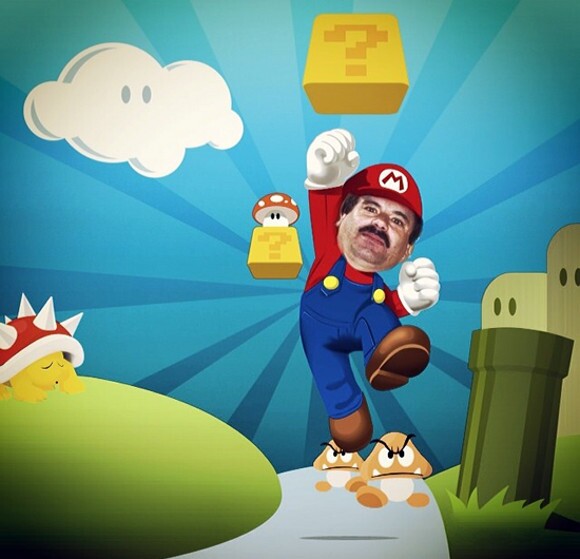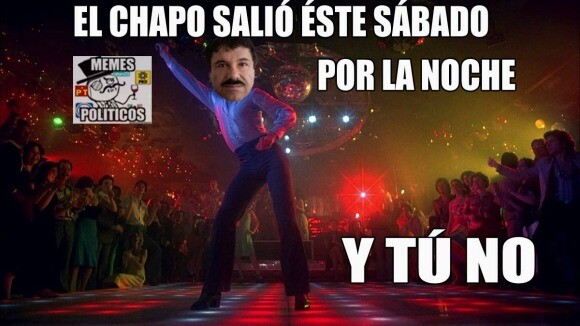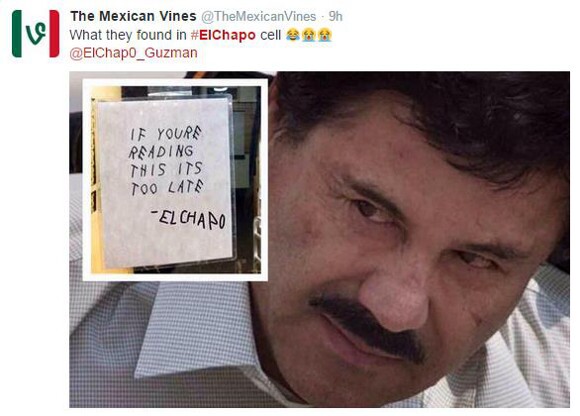How Social Media Inspired New Corridos About El Chapo's Escape

This past Saturday, rumors began circulating of the escape of Mexican drug kingpin, Joaquin "El Chapo" Guzman. Prominent journalists and editors posted social media updates alluding to a developing story. As the news broke, some Mexicans on both sides of the U.S.-Mexico border have relished in the tragic humor of his escape, instantaneously creating a flurry of memes on social media with funny, yet critical perspectives on news media, as well as both the U.S. and Mexican states. Some created their own corridos -- traditional storytelling ballads -- that crooned about El Chapo and posted them online. Perhaps for the first time, social media preceded and fed the real-time writing of corridos that until now, had typically functioned as an important source of popular, oral story-sharing. Social media feeds became a zocalo showcasing homemade graphics, songs, and videos made by ordinary people, displaying a kind of digital folk art that satirized the absurdity of El Chapo's escape.
Details of the escape were as simple and unbelievable as a James Bond movie. According to early reports, El Chapo's accomplices built a tunnel leading from El Centro Federal de Readaptación Social Número 1, a maximum-security prison also known as El Altiplano, to an abandoned construction site a little more than a mile away. Leading out from the shower of his cell, the tunnel was complete with lighting, a ventilation system, and a motorcycle fitted onto railings. The tunnel measured five-foot-six inches in height, just one inch taller than the man known as "Shorty."

As news emerged of El Chapo's escape, Mexicans across the political spectrum and level of education took to social media to engage the most recent development in the so-called "War on Drugs." One meme noted Guzman's resemblance to Mario from the Nintendo game Super Mario Brothers and simply superimposed text to an image of Mario on top of a green tunnel. Guzman, like Mario, evades his enemies by dipping in and out of tunnels. In video games, and in Mexico too, the meme seems to suggest, controlling one's future is about knowing which buttons to push.
While the public used Facebook and Twitter posts and memes to ridicule the Mexican state's official narrative of Guzman's escape, one Los Angeles journalist and author, Sam Quinones, even penned his own corrido about the second escape. After all, before Twitter and the 24-hour news cycle, corridos were almost a prototypical meme, where troubadours would extol stories and share information -- whether true, propagandized, or fantastical -- which were then passed along to other balladeers as the songs metastasized across Mexico.
El Chapo is a household name for Mexicans on both sides of the border and during the 2000s, when Guzman emerged as one of the most venerated subjects of the wildly popular narcocorrido genre of Mexican music. His rise from abject poverty to the Forbes list of billionaires has been chronicled in countless corridos. Written for, and consumed by, popular classes, the traditional Mexican ballad typically chronicles heroic exploits of outlaws and revolutionaries like Emiliano Zapata and Pancho Villa. Corridos played a central role in the U.S. Southwest throughout the 19th and 20th centuries. In "The Corrido de Joaquin Murrieta," Los Madrugadores narrated the valiant acts of the 19th century Robin Hood-like character for 1930s Los Angeles. Like any good ballad, Roberto Tapia's corrido about El Chapo resonates with working class Mexicans at home and abroad:
de niño vendió naranjas aya por la sierra
nomas pa poder comer
nunca se avergüenza de eso
al contrario lo dice que fue un orgullo pa el
As a boy he sold oranges in the mountains
Just so that he could eat
He was never ashamed of that
On the contrary he says he was proud of it

Guzman's first escape from the federal penitentiary at Puente Grande in the state of Jalisco provided new fodder for narcocorridistas. Songs like Los Tucanes de Tijuana's "El Regreso del Chapo," Valentin Elizalde's "El Escape del Chapo," and El Komander's "Estrategia de Escape," emphasized the inevitability of his escape, the careful planning that went into it, the complicity of government agents, and vast sums of money required to execute it. As Los Tucanes described it, El Chapo's escape from Puente Grande was the "first goal" scored by the Sinaloa Cartel against the incoming Vicente Fox administration.
But the legend of his escapes wasn't only built on his escapes from prison, but also from the many times he avoided capture. In 2012, El Chapo escaped capture at the hands of federal police who raided a mansion in Los Cabos where Guzman was thought to be vacationing. The missed opportunity was considered an embarrassment for the outgoing Calderón administration. The episode was memorialized in Calibre 50's song "Se Quedaron A Tres Pasos."
Por algo es una leyenda
imposible de atrapar
dicen que escapo por tierra
otros que se fue por mar
el les sigue dando guerra
no lo busquen por La Paz
"Se Quedaron A Tres Pasos"
a tres pasos de Guzmán...
lo buscaban en Los Cabos
y el ya estaba en Culiacán...
There's a reason he's a legend
Impossible to catch
They say he escaped by land
Others that he left by sea
He keeps giving them war
Don't look for him in La Paz (peace)
They stayed three steps away
Three steps from Guzmán
They looked for him in Los Cabos
But he was already in Culiacán
On February 22, 2014, the Mexican state finally got its man. Mexican marines captured Guzman at a hotel in Mazatlán, providing President Peña Nieto with evidence of a successful campaign against the Mexican cartels. This victory coincided nicely with a positive feature in Time magazine. The cover, a portrait of the president with the words, "Saving Mexico," caused an uproar among activist, journalists, and Mexican citizens.
Then this week, he escaped again, and the memes started rolling in. The details of his escape and the political context shaped the memes and posts, while providing an interesting, critical perspective on the "War on Drugs" that was distant from the political rhetoric of either nation. Playing on the widely popular Youtube video of a drunk man at a party slurring the words "if you know how I am, then why did you invite me," one meme read: "If you know that I escape, then why do you put me in jail." Others emphasized his escape as a personal choice, simply stepping out of prison as a casual affair. El Chapo, Mexicans wrote on social media, maybe just wanted to get some barbeque. On Facebook and Twitter many lamented that unlike them, even El Chapo was going out on a Saturday night.


Are these ideas not too far-fetched, given the extended privileges and liberties that El Chapo enjoyed his first time in prison? Of course, the tunnel did not escape scrutiny. One tweeter shared a large roll of U.S. dollars, thus alluding to the cash needed for such an endeavor and the corruption of the Mexican state. Building a tunnel is laborious, time consuming work, especially within such close proximity to a maximum-security facility. If four workers labored for eight to ten hours daily, estimates engineer Alfredo Turrent in an article in Milenio, a leading Mexican newspaper, it would have taken them 352 days and an equal number of loaded trucks. The dirt, after all, has to go somewhere. But then again, the Sinaloa Cartel, which Guzman heads, has built an empire on tunnels. U.S. and Mexican authorities have discovered hundreds of drug tunnels in the border regions controlled by the Sinaloa Cartel. In 2012, DEA agents uncovered a massive tunnel near Yuma, Arizona, that officials estimate would have cost as much as $2 million to build. At 755 feet, that tunnel pales in comparison to the custom-built tunnel allegedly used to free Guzman.

As a symbol, the tunnel points to the continued corruption among the Mexican state, collusion between local police, politicians, and narcos, and widespread civil rights abuses as evidence of a changing same. The disappearance of 43 Mexican Ayotzinapa Normal School students in September of 2014 confirmed these opinions. Writing for Global Research, Richard Roman and Edur Velasco Arregui note that "60 percent of the Mexican production of poppies and opium gum for making heroin," which is sold and consumed in the United States, takes place in the state of Guerrero.
The complicated relationship between Mexico and the U.S. is not lost on Mexicans. "Imagine that you are a typical Mexican citizen," writes Froylan Enciso, a Mexican academic and author of "Nuestra historia narcótica: pasajes para (re) legalizar las drogas en México." "During the last seven years, you have read daily headlines about hundreds of thousands of killed, disappeared and displaced people because of the current 'War on Drugs' that is fully backed by the U.S. government with equipment and money provided by taxpayers through the Merida Initiative. At the same time, you read that some states in America have decided to legalize marijuana, while in Mexico drug related violence increase its victims for the thousands." Some social media users hope that El Chapo might "go after Donald Trump," the U.S presidential hopeful who recently referred to all Mexican migrants as rapists and criminals.
Trying to make sense of the various responses on social media, Susana Iglesias, a Mexican novelist from the barrio of Tepito asked "Who do you sympathize with Nieto or El Chapo?" It is tempting to say that Mexicans favor El Chapo, but this might be too simplistic a reading. While some do celebrate his escape, the Mexican state and by extension its failed policy, are almost always implicated. What is more impressive still is that social media instantly questioned the official narrative of the escape, tunnel and all. It was only in the last few days that journalists, among them Diego Osorno, began to points to facts that make the tunnel escape dubious at best. Corridos will likely continue to be sung, but it might be the one-liners and memes that prove to be for and by the people most affected by the ongoing "War on Drugs."

Dig this story? Sign up for our newsletter to get unique arts & culture stories and videos from across Southern California in your inbox. Also, follow Artbound on Facebook, Twitter, and Youtube.